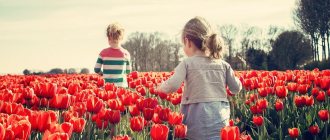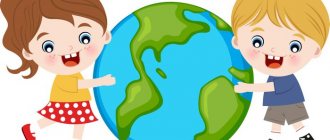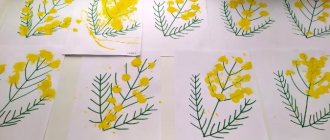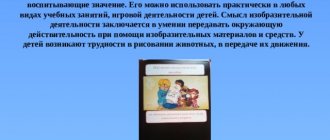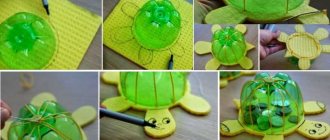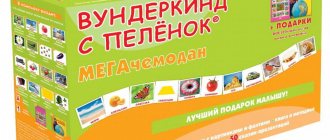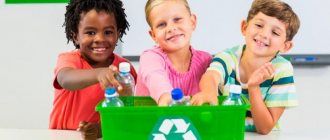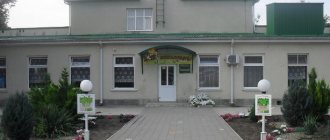Article on the topic “Methods and techniques of environmental education of preschool children”
Essay on the topic of:
“Methods and techniques of environmental education of preschool children”
“A man became a man when he heard the whisper of leaves and the song of a grasshopper, the murmur of a spring stream and the ringing of silver bells in the bottomless summer sky, the rustle of snowflakes and the howling of a blizzard outside the window, the gentle splash of a wave and the solemn silence of the night - he heard, and, holding his breath, listens hundreds and thousands of years of wonderful music of life.”
V. A. Sukhomlinsky
The basis for educating a child’s value attitude towards the natural world around him is his stable need for communication and interaction with nature. This task can be achieved through the use of the entire range of methods and forms of working with children on their environmental education.
Teaching methods
- these are ways of joint activity between the teacher and children, during which the formation of ideas, abilities and skills and the development of attitudes towards the world around them are carried out.
In environmental education of preschool children, the classification of teaching methods according to sources of knowledge is widely used.
Let's use the classification of teaching methods, differentiated by the source of knowledge that children receive. This classification was formulated by E. Ya. Golant, D. O. Lorkipanidze and E. I. Petrovsky and assumed the use of the following groups of methods for the formation of environmental culture:
Visual methods
- allow children to form vivid, concrete ideas about nature; they most fully correspond to the possibilities of cognitive activity of preschool children.
Verbal methods
- are used to expand children’s knowledge about nature, systematize and generalize it. They help to form in children an emotionally positive attitude towards nature.
Practical methods
- are used to clarify children’s ideas, deepen them by establishing connections and relationships between individual objects and natural phenomena.
1. Visual methods.
Observation
- purposeful, systematic perception of objects and phenomena of the surrounding world. This is a complex cognitive activity that involves perception, thinking and speech and requires sustained attention. In understanding the observed phenomenon, the experience, knowledge and skills of the child are essential.
By organizing observations in nature, the teacher solves a number of problems in a complex:
- Forms children's knowledge about nature.
- Teaches you to observe.
- Develops observation skills.
- Develops aesthetic feelings.
Depending on the cognitive tasks, the teacher uses various types of observation. Based on the content, observations are conventionally divided into two types: natural history - in a park, forest, river, meadow, etc., as well as in a zoo, botanical garden (they are carried out in different seasons); observations of agricultural objects - in the field, at a poultry farm, in a garden, vegetable garden, etc. in order to familiarize themselves with the work of adults. To successfully achieve the goal, the teacher thinks through and uses special techniques that organize the active perception of children: asks questions, offers to examine, compare objects with each other, establish connections between individual objects and natural phenomena. The inclusion of various senses in the process of observation ensures the completeness and specificity of the knowledge being formed. Observation must be accompanied by precise speech from the teacher and children so that the acquired knowledge is assimilated. Since observation requires concentrated voluntary attention, the teacher must regulate it in time, volume and content.
The systematic use of observation in getting to know nature teaches children to look closely, notice its features and leads to the development of observation, and therefore the solution of one of the important tasks of mental education.
Observation can be carried out both with individual children, with small groups, and with the entire group of pupils. Depending on the goals set by the teacher, observation can be episodic, long-term and final (generalizing).
The teacher's preparation for observation begins with the selection of an object. If an animal is observed, it is necessary to create an environment in which the animal behaves freely and naturally. For example: when observing a rabbit, a fairly spacious pen is built for it, around which children are placed on chairs. A rug should be placed on the floor, otherwise the animal will slide on the smooth floor. In order to arouse interest, an emotional attitude to observation, and ensure an aesthetic perception of objects, the teacher uses poetry, small forms of folklore when working with children, and with older children, during the lesson, also reading excerpts from works of art. observation must proceed in a certain sequence. Using various techniques for presenting a task, the teacher accustoms children to a consistent story about what they observe: the size, shape of an object, cover, color, peripheral parts and their features, and when observing an animal, its behavior. This order is necessary especially when children get acquainted with a new object. Let me give you an example:
Observing fish in an aquarium.
Target:
Clarify children's ideas about the appearance of fish: the body is covered with scales, there are fins on the body, back, sides, abdomen and tail; fish live in water. Learn to note the characteristics of fish of different species, establish differences (in size, body shape, color, behavior in the aquarium) and similarities.
— By what signs? (presence of common body parts, nature of movement; body covered with scales, live in water).
Organization of observation.
In addition to the previous ones, new fish are introduced into the aquarium. All the children sit down near him.
Progress of observation.
The teacher suggests remembering the names of the fish living in the aquarium, and also telling how the children looked after them, draws attention to the fact that new inhabitants have appeared in the aquarium, “What are they like?” - asks the teacher. If the children find it difficult to answer, ask additional questions: “Are the fish big or small? What color are they? Where are their fins? How do fish swim? After this, he tells the name of the new fish, invites the children to compare them with those that lived before, to establish differences and similarities. You can throw food and watch how the fish take it and how they swim. The teacher asks additional questions as needed. He asks what other fish the children know and where the fish live. with appropriate questions leads them to identify the essential characteristics of fish and generalize. Then he tells you the rules for caring for new fish. At the end of the lesson, he gives the task to observe how the fish take food, how much they eat, and whether they can live together with old fish.
Looking at paintings.
When introducing nature to younger groups, plot and subject pictures (wild, domestic animals; vegetables, fruits) are used.
In the senior class, artistic paintings are also considered (“Golden Autumn” by Levitan, “The Rooks Have Arrived” by Savrasov, “Winter” by Shishkin, etc.), they are necessary for the development of aesthetic perception and feelings of children.
Subject and subject pictures help to consolidate and clarify ideas about what was previously seen (For example: on a walk they watch birds, and then in a group they look at the corresponding illustration, repeat the names of the birds and their characteristic features). Demonstration of paintings and illustrations helps children imagine those aspects and properties of the objects and phenomena being studied that they cannot directly perceive.
Demonstration of filmstrips, film and television films
- allow you to expand the volume of knowledge about nature, ensures a more sustainable assimilation of knowledge. I would like to note the role of films and television films, which make it possible to show preschoolers nature in natural conditions, the diversity of relationships between living organisms and the environment, the growth and development of plants and animals. Nowadays, computers are especially widely used, which makes the learning process more attractive.
Demonstration of models.
Models are material substitutes for real objects and natural phenomena, reflecting their characteristics and structure. There are different types of models.
a) Subject - various objects and structures (aquarium model of a reservoir), wind-up toys (allow children to form an idea of appearance and movement), analogue toys).
b) Subject-schematic - in them, essential connections, features and relationships are presented in the form of model objects. (For example, to depict the color of leaves, strips of colored paper of the corresponding color are used, and the shape of the leaf is used using various figures)
c) Graphic - conditionally convey signs, connections, relationships of natural phenomena (nature calendars, ecological pyramid, long-short legs model, etc.)
Demonstration of models is used to describe a new object (the child looks at the model so as not to forget anything), compare objects (find similarities and differences), for generalizations and, on this basis, systematize knowledge. Visual methods contribute to the formation in children of clear, complete ideas about the world around them, the development of perception, visual-effective and visual-figurative thinking and speech, play and work activities.
2.Verbal methods
have a certain significance for instilling in children a value-based attitude towards nature, an emotional and aesthetic response to its objects. With their help, children’s knowledge about nature is systematized and generalized, and natural history knowledge is formed.
Story
- used for the purpose of initially familiarizing children with objects and objects of nature. Its goal is to create in children an accurate, specific idea of a particular natural object. The story must be imaginative and colorful, using words that are familiar and close to children. The story should attract the attention of children, stimulate the development of thinking, cognitive processes, and imagination. The story should be well accompanied by a demonstration of illustrations, photographs, and slides. This helps children understand its meaning.
Conversation as a method of introducing children to nature.
Conversation is used by educators for various didactic purposes:
- to arouse interest in the upcoming activity (before observation, excursion);
- to clarify, deepen, generalize and systematize children’s knowledge about nature, to form an attitude towards nature.
In each conversation, the problem of developing children's speech is solved.
Conversations about nature are usually divided into the following types: introductory, heuristic and final.
Introductory conversation
helps the teacher gather children’s attention, arouse interest in the upcoming activity, update existing experience in order to establish a connection between previously acquired knowledge and the upcoming excursion, observation, etc.
Heuristic conversation
involves establishing the causes of various natural phenomena using reasoning. Such a conversation is based on the children’s existing knowledge gained during the observation process. It is aimed at deepening knowledge about the relationships that exist in nature, and children independently solving cognitive problems.
Final conversation
used to generalize and systematize children’s knowledge about nature, obtained in the process of observations, games, reading works of art, work, etc. The final conversation is organized by the teacher, starting from the middle group. It is carried out as children accumulate ideas about nature and only if these ideas are mastered by all children.
The next verbal method is reading works of fiction.
In the hands of a teacher, a children's book about nature has great educational value. It expands children's understanding and introduces them to phenomena that are impossible to directly perceive. A natural history book reveals to children the phenomena of inanimate nature, helps to establish connections and relationships that exist in nature. The founders of Soviet children's natural history books are V.V. Bianchi, M.M. Prishvin, K. Paustovsky, N. Sladkov. Pavlova introduced a new genre - environmental fairy tales, which in a fascinating way introduce the creatures inhabiting planet Earth, teach us to understand their needs and relationships, and reveal the secrets of complex phenomena and miraculous transformations in nature. The ecological fairy tale was further developed by Shorygina and Ryzhova.
3.Practical methods.
A game
is a method by which children get acquainted with the world around them. The younger the children, the more often the game is used as a method of educational work. Outstanding teachers (Leontyev, Elkonin, Zaporozhets). called play the leading activity of preschoolers?
Didactic games –
games with rules and ready-made content. In the process of didactic games, children clarify, consolidate, and expand their existing ideas about objects and natural phenomena, plants, and animals. Games give children the opportunity to operate with objects of nature, compare them, and note changes in individual external signs. Many games lead children to the ability to generalize and classify, and evoke an emotional attitude towards nature.
Board-printed games
- these are games like lotto, dominoes, cut and paired pictures (“Zoological Lotto”, “Four Seasons”, “Plants”, “Pick a Leaf”, etc.).
In these games, children’s knowledge about plants, animals, and inanimate natural phenomena is clarified, systematized, and classified.
Word games
- these are games the content of which is a variety of knowledge available to children, and the word itself. They are carried out to consolidate children’s knowledge about the properties and characteristics of certain objects. These are games like “Who flies, runs and jumps?”, “What kind of bird is this?”, “When does this happen?”, “In the water, in the air, on the ground”, “Necessary - not necessary”, etc.
Outdoor games of nature history
associated with imitation of the habits of animals, their way of life. By imitating actions, imitating sounds, children consolidate knowledge; The joy gained during the game helps to deepen interest in nature. For example, such games as “Hen with Chicks”, “Mice and Cat”, “Wolf and Sheep”, etc.
Experimental games
allow you to verify the authenticity of physical and natural phenomena and patterns (“Drowning or not drowning”, “Soap bubbles”, “Let’s make solutions”, “Which water is easier to swim in”).
, competitive games and travel games
can be successfully used Experiments
— observations carried out in specially organized conditions. They are used for children to establish certain phenomena, connections, relationships between objects and natural phenomena. The experiment can take place either as a long-term comparative or as a short-term observation. The final point of the experiment is the formulation of conclusions based on the results obtained. The teacher encourages children to form their own conclusions. Experiments that can be carried out with children (a branch in a cool and warm place (depending on heat); a plant in a dark and light place (depending on lighting); a plant with and without water (the need for water for growth), etc.) In progress When organizing experiments, living objects must not be brought to death or their vital manifestations disturbed. Therefore, as soon as noticeable changes appear. The conditions must be changed immediately. Experiments contribute to the formation of children's cognitive interest in nature, develop observation and mental activity. In each experiment, the cause of the observed phenomenon is revealed, children are led to judgments and conclusions. Experiments are of great importance for children’s understanding of cause-and-effect relationships. Experiments are most often carried out in older groups of kindergarten. In the junior and middle groups, the teacher uses only individual search actions. Experience should always be built on the basis of existing ideas that children received in the process of observation and work. Its task and purpose should be clear to preschoolers.
Modeling
is considered as a joint activity of the teacher and children to build models. The purpose of modeling is to ensure that children successfully acquire knowledge about the characteristics of natural objects, their structure, connections and relationships that exist between them. It is based on the principle of replacing real objects with objects, schematic images, and signs.
Work.
It is used in kindergarten in the daily care of plants and animals on a plot of land and in a corner of nature, sometimes in classes. Children's work cannot be turned into an end in itself. While developing labor skills, one should simultaneously expand or consolidate knowledge about nature (before sowing, consider the seeds (shape, size, color); before planting cuttings, repeat the names of the parts of the plant (stem, leaves, flowers). Strong physical labor has a beneficial effect on overall development children, improves the functions of their analyzers, and primarily the motor
Project method
Modern education requires teachers to use the most effective pedagogical technologies in educational practice, which would help the child master the necessary knowledge and skills of behavior in nature. One of these technologies is the project method
, which in recent years has become very firmly established in the practice of preschool educational institutions.
The peculiarity of project activities is that they are integrated in nature, they solve a complex of educational problems, involving children in activities related to different educational areas. Another feature is that the implementation of projects, as a rule, takes a long time and ends with the creation of a “product” in the form of exhibitions of crafts, drawings, and the organization of holidays.
The project method allows children to gain experience on their own. Learning takes the form of research, the application of existing knowledge in activities, the results of which are truly interesting to the child. Project activities make preschoolers active participants in the educational process and help them independently master the surrounding reality. By participating in projects, a child develops, learns to find a way out of a difficult situation and becomes more confident in his abilities.
When working on environmental education of children, it is necessary to use different methods in a complex and correctly combine them with each other. The choice of methods and the need for their integrated use are determined by the age capabilities of the children, the nature of the educational tasks that the teacher solves. For example, the formation of knowledge about the way of life of a rabbit is impossible without observations; children learn about ways to care for indoor plants in the process of work; about the properties of snow and ice - during experiments or games. Knowledge about wild animals is formed during reading or storytelling by the teacher.
RECEPTION is part of the method, its specific element. (techniques help implement teaching methods).
Reception
- this is a particular definition of a particular method of education. This is a separate action of the teacher within a specific method. In relation to the method, the technique is of a subordinate nature. There are various methods of environmental education.
Techniques that arouse interest
. (For example: on the eve of watching the fish, you can invite the children to wash the aquarium together with the teacher, or before showing the rabbit, peel vegetables for it. Children’s interest is also awakened after talking about the animal that will be brought to the group, asking riddles about him.
Reception of examination
- helps to highlight the sensory attributes of objects. (For example: in order for kids to know what kind of fur a kitten has, they are asked to carefully stroke it and determine whether it is fluffy or smooth. Or in order to find out the nature of the surface of a tree trunk, children examine it and identify signs (smooth, rough, etc.) .P).
Techniques of imitation.
a) movements (using folded palms, invite the children to move them like a fish with its tail. b) sounds (meow, crow).
Method of comparison.
Its task is to establish signs of difference or similarity of objects in size, color, nature of movement, etc. (when observing a tree and shrub, children can ask the following questions:
· How many trunks does a tree have and a shrub have (one/many).
· What kind of trunks do trees and shrubs have (thick/thin).
· Which is taller, a tree or a shrub (tree).
· What kind of bark does a tree have, what kind of bark does a bush have (thick/thin), etc.
Game and surprise techniques
- used to draw attention to an object. (you can unexpectedly bring an animal to the group or tell the children that they are invited to visit. These surprise moments will revive children’s interest in animals. Various characters can be used in classes - the fairy Flora, who talks about plants; Dunno, who often confuses the seasons and their signs; An old forest man who invites you to visit him or sends tasks to children.
Problematic experiences.
(To find out what a hedgehog eats, put an apple, candy, fish in front of him and see what he chooses).
Comparisons.
(Compare where onions grow better - in the light or in the shade).
Approaching an object.
(Do not observe on the site, but bring the branch to the group).
Use of artistic words
. (Read a poem about a birch tree).
Assessment of children's activities.
Questions for children.
Conclusion:
There are many different teaching methods and techniques that help to form children’s environmental ideas, and the quality of environmental education for preschoolers depends on the ability to correctly combine and apply them.
What is S.N. Nikolaeva’s book about on methods of educating preschoolers about ecology?
Svetlana Nikolaevna Nikolaeva is a Doctor of Pedagogical Sciences, chief researcher at the Institute of Psychology, dealing with childhood problems. The author of scientific works on pedagogy is known for her research related to environmental education. She reveals this topic in her work “Methods of environmental education of preschool children.”
Palms holding children and rainbow
The textbook was written by a person with extensive experience in raising children. According to Nikolaeva S.N., environmental education should begin with stories about nature. And when the child’s consciousness is filled with the necessary information, it is possible to consolidate in the pupil a certain attitude towards the environment:
- educational;
- aesthetic;
- humanistic.
Important! Nikolaeva S.N. “Methods of environmental education of preschool children” is a work in which the author expresses confidence: a person’s attitude to the natural environment is an indicator that shows how educated he is in environmental terms. And it is important to start such education as early as possible, from the preparatory group of kindergarten, consolidating it in the middle and senior groups.
The teacher proposes a method of environmental education, which consists of two main points:
- transfer knowledge on ecology;
- modify them into relationships.
Environmental education of Nikolaeva’s preschoolers should be about achieving the final result when the child consciously treats nature with care. Realizing that he too is part of this environment.
Planet with a butterfly in human palms
Effective environmental education through play activities
Through the game, the understanding of the life of plants and animals gained during excursions and direct contact with the inhabitants of the meadow, forest, and pond is consolidated.
Ecological game technology:
- Selecting a topic from the program.
- Determining the purpose and conditions of the game.
- Thinking through the stages of the game.
- Distribution of roles.
- Getting to know the rules.
The method of teaching such games depends on the characteristics of the preschooler’s age. There are different types of games: subject, board, verbal, creative. When creating creative game situations, you can use fairy-tale characters.
For example, Little Red Riding Hood goes to her grandmother through the forest and can meet its different inhabitants and collect leaves of forest trees. Toys are important for games: dolls, fish, animals. They should be aesthetic, bright, realistic. In this case, the game stimulates the activity of children and increases their emotional mood.
Application to the program
To successfully implement this goal, Svetlana Nikolaevna has developed a special program. This is “Young Ecologist” for Nikolaeva’s preparatory group.
This manual examines the issue of environmental education and culture of children in preschool age. The basis of the book consists of theoretical and practical research on this topic. The author devoted several decades to this work.
Note! Tentatively, the readers of the book should be practitioners involved in preschool education, teachers and students of pedagogical institutes and pedagogical colleges.
The “Young Ecologist” application provides for the study of the following topics:
- Plants, animals and humans live among living and inanimate nature.
- Plants and animals are diverse, they are united by their habitat.
- Plants and animals grow and develop in their environment.
- Man constantly interacts with nature.
Didactic game on the topic of ecology in senior groups of preschool educational institutions
For which kindergarten groups is this book suitable?
Ecological culture in a kindergarten should be instilled by the teacher. Therefore, it is important for him to understand the significance of environmental problems and the reasons that gave rise to them. This technique was developed for children starting from junior kindergarten age - the preparatory group.
“The Theory and Methods of Environmental Education for Children” by Nikolaeva S.N. is intended specifically for the youngest pupils of a kindergarten, since even then children can learn important information:
- how plant and animal organisms and habitats are related;
- how diverse are living organisms that are in ecological unity;
- what communities do living organisms unite into?
- a person is a living being, in his habitat he receives all the conditions for healthy and normal, high-quality life;
- people use natural resources, but at the same time pollute the environment;
- it is important to protect and restore natural resources;
- The end result of the implementation of the methodology should be a conscious, careful attitude towards the environment.
Important! The main aspects of the program are as follows: the end result of environmental education work is attitude. The teacher is assigned the role of a carrier of ecological culture.
A teacher and children from a kindergarten group during a lesson
Environmental education in kindergarten
Already at a young age, the baby begins to interact with peers, with adults, with objects of nature.
The child shows curiosity, asks why questions, and adopts the values and traditions of elders. Ages from 3 to 6 years are the most susceptible. A preschooler learns the experience of adults based on trust in them. From an early age he learns to actively cooperate with nature and empathize with it.
Environmental education starts in the family and continues in the nursery. Each preschool institution draws up its own program for the formation of environmental knowledge, covering the entire educational process, starting with a walk and ending with educational activities.
System of work on education of ecological culture of preschool children
Forms of environmental education
Classes
The main form of environmental education in kindergarten is an activity. On them, children’s intuitive ideas are transformed, deepened, and expanded. The process of environmental education of preschoolers takes place in several types of classes:
- During the initial orientation classes, children get acquainted with plants and animals, their habitat and growth, and living conditions. This refers to those objects of nature that cannot be observed around you. The teacher talks about plants and animals, shows their appearance, introduces them to the manners, habits of animals, and the characteristics of plant growth. Paintings, videos, conversation, reading excerpts from works of art, for example, stories by V. Bianchi, are used as visual aids. Introductory classes are held in all groups.
- In-depth cognitive classes are designed to form preschoolers' understanding of the connections between plants and animals, the relationship between plant growth and the weather conditions of a certain area, the dependence of animals on environmental factors, the adaptability of animals, reptiles, and birds to natural conditions. The means of visualization here can be demonstration of models of natural complexes, targeted conversation, and primitive experiments.
- In general-type classes, knowledge is systematized, a unified picture of a particular natural environment is formed, conclusions are drawn about the relationship of flora and fauna, climatic conditions, and soil. For example, general lessons on the topics “Autumn”, “Winter”, “Spring”, “Summer”.
- Classes of a complex nature are based on the interaction of different types of activities: creative, gaming, artistic. They often extend beyond one activity. Alternating between playing and drawing, reading and watching does not tire preschoolers. If this happens, physical exercises or physical exercises come to the rescue.
Excursions
This is one of the most interesting forms of work. The advantage of the excursion is that preschoolers can directly contemplate the inhabitants of a zoo, park, meadow, or square. They can listen to birds singing, smell flowers, stroke animals and reptiles, examine their appearance, observe their behavior and nutrition. These are nature excursions.
You can take your children on excursions to agricultural enterprises: greenhouses, orchards, greenhouses, vegetable gardens. Such trips are organized to get acquainted with the work of people at different enterprises. Conducting excursions requires a lot of preparation: the teacher needs to familiarize himself with the method of conducting it, think through the main stages, types of activities, techniques that may be of interest to preschool children.
Search activity
Primary search activities are organized for older preschoolers. In the course of joint work, a problematic question is formulated that requires searching for an answer: why do birds fly south? Why is the snow melting? Why are the leaves falling?
The search activity represents either a heuristic conversation, an observation, or an experiment.
